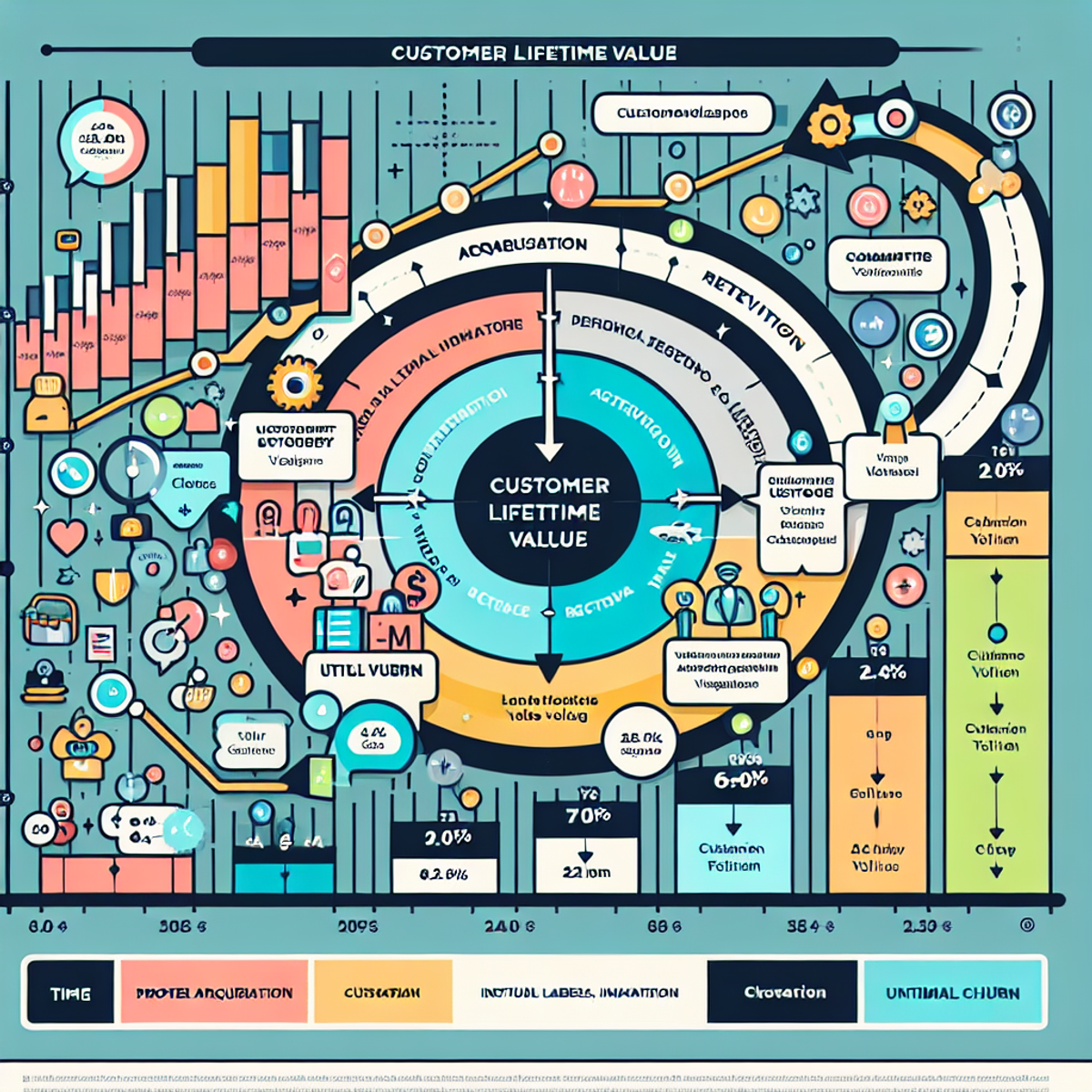Maximizing Sales Rep KPIs: How to Measure and Improve Performance

Introduction
Welcome to the world of sales performance indicators and key performance indicators (KPIs). In the realm of sales, these terms are much more than mere jargon. They form a tangible framework for measuring success, setting targets, and driving growth.
Sales Performance Indicators serve as a lamp in the dark, shedding light on how well your sales team is performing against set objectives. They provide a quantifiable measure of success and offer insights into areas that need improvement. This could include metrics such as the number of deals closed, average deal size or the number of new leads generated.
On the other hand, Sales KPIs are like a compass guiding you towards your destination. They are highly focused and are tied directly to strategic business goals. Examples include annual revenue targets, customer retention rates or lead conversion rates.
A robust CRM (Customer Relationship Management) system can be instrumental in tracking these indicators and KPIs effectively. The data collected can be analyzed to unveil trends, recognize patterns and make informed decisions aimed at improving sales performance.
Success in business is often a result of small incremental improvements over time; this holds particularly true for sales. Hence, measuring and optimizing sales rep performance is not just important — it’s essential for business success. By closely monitoring sales performance indicators and KPIs, you can identify strengths to build upon and weaknesses to address in a proactive manner.
Remember: What gets measured gets improved. So let's dive into how you can maximize your sales rep KPIs to drive sales performance and ultimately, achieve business success.
1. Key Metrics for Measuring Sales Performance

When evaluating the effectiveness of a sales team, it is crucial to rely on key performance indicators (KPIs) that provide a comprehensive view of their success. These metrics offer valuable insights into performance, areas that require attention, and opportunities for growth.
Revenue Goals
Setting revenue goals is a cornerstone for assessing sales performance. These goals, when properly aligned with market opportunities and company capacity, act as benchmarks to determine the effectiveness of your strategies. Analyzing revenue trends allows you to:
- Break down revenue by individual reps to gauge productivity
- Compare actual sales against targets to identify gaps
- Project future sales and adjust tactics accordingly
Customer Retention
Customer retention, a reflection of satisfaction and loyalty, is a vital metric for sustainable growth. High retention rates often indicate:
- Strong customer relationships
- Product or service value affirmation
- Lower acquisition costs in comparison to finding new customers
Conversely, low retention rates can signal issues with your product, customer service, or competitive positioning.
Lead Generation
Lead generation fills the sales pipeline with potential customers and indicates the future health of sales activities. Effective lead generation involves:
- Monitoring the number of new leads over specific periods
- Assessing the quality of leads based on their conversion likelihood
- Optimizing marketing strategies to attract qualified leads
Without a consistent flow of leads, revenue goals may become increasingly difficult to achieve.
Average Sales Amount
The average sales amount provides insight into transaction value and helps in forecasting revenues with greater accuracy. By understanding this metric, you can:
- Identify trends in purchasing behavior
- Tailor upsell or cross-sell strategies accordingly
- Set benchmarks for individual sales rep performance
Improving the average sales amount can significantly impact overall revenue without necessarily increasing customer numbers.
Customer Lifetime Value (CLV)

CLV predicts the total worth of a customer to your business over the entire duration of your relationship. A high CLV suggests:
- Effective up-selling and cross-selling techniques
- Positive long-term business prospects from loyal customers
- More efficient use of marketing resources
Strategies aimed at maximizing CLV focus on enhancing customer experiences and fostering loyalty. To learn more about calculating CLV, you can refer to this resource.
Conversion Rate
The conversion rate is a critical measure of how effectively leads turn into paying customers. It provides actionable insights into:
- The potency of your sales funnel stages
- Reps' abilities to close deals
- The effectiveness of your qualifying processes
By monitoring conversion rates closely, you can pinpoint where prospects drop off and why—information essential for optimizing sales processes.
These metrics, when used collectively, offer a comprehensive framework for evaluating outcomes and guiding strategic decisions aimed at boosting productivity and driving revenue growth in B2B sales. By continuously monitoring these key metrics, you ensure that your sales efforts align with overarching business objectives while identifying opportunities for improvement at both individual and team levels. To gain further insights on B2B sales metrics, you may find this resource helpful.
2. Understanding the Role of Sales Performance Indicators and KPIs for Reps

Sales performance indicators and KPIs are not just fancy terms; they are powerful tools that can help sales reps understand how well they're doing. One important indicator is the rep retention rate. This shows how good a rep is at keeping customers happy and interested.
A high rep retention rate means the rep is great at communicating, building relationships, and consistently meeting customer needs. On the other hand, a low rate may indicate areas for improvement, such as closing deals or managing relationships.
To calculate the retention rate, divide the number of customers who stayed with you by the total number of customers you had at the beginning of a specific time period. It's crucial to keep an eye on this KPI because it directly affects your revenue - losing customers means losing potential sales.
Another essential KPI is ramp time, which measures how quickly reps can start contributing to the sales team. This is especially important for new hires. A shorter ramp time shows that a rep can understand and adapt to your company's sales process faster, which leads to quicker success for the team.
To calculate ramp time, measure the period from when a rep starts their role until they reach full productivity (usually defined by when they meet their sales quota consistently).
Remember that there's no universal standard for ramp time - it depends on factors like your industry, product complexity, and training effectiveness.
Other important KPIs to consider are:
- Referrals: The number of new leads generated through current client referrals can indicate how satisfied your customers are.
- Churn Rate: If customers are leaving at a high rate, it could mean they're unhappy with your product or service.
These specific KPIs give valuable information about how well an individual rep is performing. Understanding them can help reps adjust their strategies to meet and surpass their goals.
Sales performance indicators and KPIs aren't just numbers to aim for; they provide insights for continuous improvement. By paying attention to these metrics, sales reps can identify their strengths and areas where they can get better, leading to more success in the long term.
Remember, continuous learning is important in sales. So, using these KPIs can give you the knowledge you need to keep growing in your sales career.
In the next section, we'll look at how you can accurately track and measure these important KPIs.
3. How to Effectively Track and Measure Sales Rep KPIs

Effective tracking and measuring of sales rep KPIs depend on using sales data diligently and implementing measurement techniques strategically. Here's how to approach this critical task:
Utilize Sales Data
Sales data is crucial for tracking KPIs. It provides factual insights into sales rep activities, customer interactions, and overall performance outcomes. When used correctly, this data can reveal trends and patterns that are essential for making informed decisions.
- Capture every interaction: Make sure to record all customer interactions, such as phone calls, emails, or meetings, in your CRM system.
- Monitor deal progress: Track how deals move through the sales pipeline to understand rep performance at different stages.
- Analyze win/loss records: Look into the reasons behind won or lost deals to identify success factors or areas needing improvement.
Identify Key Metrics
Choosing key metrics that align with your business objectives is crucial. Sales leaders should determine which metrics reflect their strategic goals and clearly communicate expectations to their teams.
- Revenue goals: Focus on metrics directly related to revenue, such as monthly sales growth or average profit margin.
- Efficiency indicators: Look at the ratio of wins to losses or the average time spent per deal to gauge efficiency.
- Customer-centric metrics: Consider customer satisfaction scores or net promoter scores (NPS) as indicators of relationship-building success.
Measure ROI
Calculating the ROI for each sales rep is important in evaluating their impact on your company's financial well-being.
- Calculate revenue generated: Divide the total revenue brought in by a rep by their salary and expenses to understand their profitability.
- Assess against targets: Compare revenue generated with set quotas to see if reps are meeting or exceeding expectations.
- Factor in intangibles: Acknowledge non-monetary contributions such as customer relationships and team leadership when assessing ROI.
Importance of Accurate Data Tracking
Using accurate methods to track data ensures that you can rely on trustworthy information when evaluating KPIs.
- Implement robust CRM systems: Use advanced CRM platforms that seamlessly integrate with other business tools to consistently capture data.
- Regularly clean data: Schedule routine database maintenance to ensure information accuracy and relevance.
- Establish uniform reporting standards: Create standardized reports for consistent analysis across all reps and teams.
By being thorough in tracking efforts and using precise measurement techniques, you can make informed decisions to improve sales rep performance. The insights gained from well-tracked KPIs act as a guide for both reps and managers to achieve sales excellence.
Now that you understand tracking and measuring techniques, let's explore strategies that not only use these insights but also encourage continuous improvement within the sales force.
4. Strategies to Improve Sales Performance Using KPI Insights

KPI insights are invaluable for identifying strengths and weaknesses within your sales team's performance. By analyzing KPIs, you can pinpoint specific areas that need improvement and implement strategies that lead to greater success in customer relationships, lead conversion rate, and employee retention.
Enhance Customer Relationships

- Personalization: Use KPI data related to customer interactions to tailor communication. If you notice a high churn rate, consider personalizing follow-ups with customers to better meet their needs.
- Customer Feedback: Actively seek out customer feedback on their experience. Use satisfaction scores as a KPI to gauge the quality of customer relationships and adjust your approach accordingly.
- Training on Soft Skills: Invest in training for your sales reps focusing on empathy and active listening skills; these are crucial for building long-term customer relationships.
Boost Lead Conversion Rate
- Qualify Leads More Efficiently: Analyze the conversion rate KPI to determine the effectiveness of lead qualification. Train your team to better identify promising leads, saving time and resources.
- Sales Process Optimization: Break down the sales process into stages and measure success at each phase. Identify where leads tend to drop off and streamline these stages for higher conversion rates.
- Incentive Programs: Motivate your sales team by using KPIs to set targets and then rewarding those who meet or exceed these goals with bonuses or other incentives.
Increase Employee Retention
- Career Development: Use ramp time and performance metrics as indicators of employee engagement. Provide clear career paths and development opportunities for reps who show promise.
- Recognition and Rewards: Recognize achievements publicly within the organization. Celebrate not just closed deals but also improvements in KPIs like customer satisfaction or lead response time.
- Work Environment Improvements: Monitor rep satisfaction through surveys and interviews as part of your KPIs. Address any concerns by investing in a supportive work environment that encourages collaboration and wellness.
By implementing these strategies based on solid data from sales performance indicators, you set your team up for continuous improvement and greater achievement in key areas like customer retention, lead conversion, and employee satisfaction. This proactive approach ensures that you are not only tracking performance but actively using this information to propel your team forward.
Remember that adaptation is key; as market conditions change, so should your strategies based on updated KPI insights. Stay agile in your approach to managing performance, always looking for ways to refine tactics based on what the data is telling you.
5. Aligning Individual Targets with Organizational Goals through KPI Setting

Aligning the aims of individual sales representatives with the broader objectives of an organization is a strategic endeavor that requires careful planning and execution. The use of KPIs is essential in bridging this alignment, ensuring that every team member's efforts contribute directly to the company's success. Sales targets and sales metrics serve as the connective tissue between personal ambition and collective achievement.
Synergy Through Strategic KPI Setting
By setting KPIs that reflect organizational goals, you create a unified direction for the sales team. This alignment enables reps to understand their role within the larger picture and drives them to work towards common ends. The following points illustrate how strategic KPI setting can foster this synergy:
- Translate Organizational Goals into Actionable Objectives: Break down overarching company goals into specific, measurable actions that reps can take on a daily, weekly, or monthly basis. For example, if the goal is to increase market share, individual KPIs might include outreach to new geographic territories or verticals.
- Personalize KPIs to Leverage Strengths: Understand each rep's unique skill set and tailor their KPIs to maximize their potential. A rep with a knack for relationship-building might focus on customer retention metrics, while another who excels in quick transactions could concentrate on volume-based targets.
- Balance Short-Term and Long-Term Metrics: Ensure that immediate sales targets do not overshadow long-term objectives like customer lifetime value (CLV) or annual contract value (ACV). This balance prevents a myopic focus on quick wins at the expense of sustainable growth.
- Regular Reviews and Adjustments: Monitor progress toward KPIs and hold regular discussions with reps to review results. Adjust targets as needed to keep pace with changing market conditions or shifts in business strategy.
The Impact of Sales Metrics on Achievement
Sales metrics provide tangible evidence of progress and areas for improvement. They are critical tools for:
- Benchmarking Performance: Use historical data to set realistic yet challenging targets. This benchmarking encourages continuous improvement without demotivating reps with unattainable goals.
- Identifying Skill Gaps: Analyze which metrics are consistently underperformed and provide targeted coaching or training interventions to address these gaps.
- Motivating Reps: Clearly defined metrics give reps a clear understanding of expectations and a roadmap for success, which can be highly motivating.
- Rewarding Success: Tie incentives directly to performance against key metrics, reinforcing the importance of aligning individual efforts with company objectives.
As each rep aligns their personal milestones with the company's aspirations through well-defined KPIs, an environment of focused collaboration emerges. Sales teams become more cohesive, driving towards shared successes while also fulfilling their individual potential. The next step involves leveraging technology to monitor these KPIs efficiently, ensuring real-time insights into performance and facilitating swift adjustments to strategies as necessary.
6. The Role of Technology in Facilitating Sales Performance Monitoring and Optimization

Sales teams work in a fast-paced environment where they need to adapt quickly and improve their performance. Technology plays a crucial role in this process, offering advanced tools like sales enablement platforms and AI-powered CRMs that make sales performance monitoring even better.
How Sales Enablement Platforms Help
Sales enablement platforms are designed to give sales reps the tools and content they need to sell better. Here's how they contribute to improving performance:
- Easily Accessible Resources: Sales reps can quickly find the right content for any sales situation, reducing downtime and increasing productivity.
- Effective Training: These platforms provide interactive training modules, making sure reps are well-prepared to meet their targets.
- Detailed Analytics: In-depth analytics help identify which resources are driving sales and how reps are using them.
With these platforms, monitoring important metrics like new leads, win rate, and pipeline aging becomes easier, allowing managers to make decisions based on data.
The Benefits of AI-Powered CRMs
Customer Relationship Management (CRM) systems have improved with the use of artificial intelligence (AI), offering a range of features that enhance sales tracking and analysis:
- Predicting Future Trends: AI algorithms use past data to forecast future sales trends, enabling proactive adjustments to strategy.
- Automating Data Entry: Reps save time by having interactions automatically recorded, ensuring no details are missed.
- Prioritizing Leads: CRMs rank leads based on their likelihood to convert, helping reps focus on the most promising opportunities.
In addition, AI-powered CRMs analyze call transcripts using natural language processing to understand customer sentiments and rep engagement levels.
Acting Quickly with Real-Time Insights
Thanks to technology, sales teams can respond immediately:
- Instant Feedback: After analyzing call transcripts or engagement data, reps receive immediate feedback on their performance.
- Learning from Data: AI-generated insights help reps understand which approaches work best, supporting continuous improvement.
By taking advantage of these technological tools in sales enablement platforms and CRMs, organizations ensure that their sales reps have the best resources available to monitor and improve their performance. This smart use of technology goes beyond just measuring metrics; it becomes a foundation for ongoing enhancement of sales processes.
Sales teams equipped with these tools can stay flexible in a constantly changing market while consistently achieving the goals set by the company. It's clear that using advanced technology is essential for staying competitive in today's fast-paced business world.
Conclusion
Understanding the significance of sales performance indicators and KPIs for a company's success cannot be overstated. These metrics play an instrumental role in measuring the effectiveness of sales reps and identifying areas for improvement.
An effective use of KPIs can support sales reps in enhancing their performance. Metrics such as monthly sales growth, average profit margin, and customer satisfaction provide insights into a rep's strengths and weaknesses. Through these insights, sales reps have the opportunity to focus on improving key areas that drive business growth.
The use of technology, specifically AI-powered CRM tools and sales enablement platforms, has made monitoring and optimizing performance more straightforward than ever before. These advanced tools have the capacity to track a multitude of metrics accurately, providing real-time data that aids in informed decision-making processes.
When it comes to sales rep performance metrics, these can be utilized as powerful levers to drive business growth:
- Revenue Growth: Understanding how much a sales rep contributes to revenue generation helps businesses allocate resources effectively.
- Customer Satisfaction: A satisfied customer is indicative of successful sales tactics and can result in repeat business.
- Sales Cycle Length: Shorter sales cycles often translate into higher efficiency and productivity among sales teams.
- Rep Retention Rate: High retention rates suggest that reps are content in their roles, which can lead to better performance.
With the proper application of these metrics, businesses have a clear roadmap to boost their overall performance. By aligning individual targets with organizational goals through strategic KPI setting, companies ensure synergy between different levels within the organization.
In essence, KPIs serve as invaluable navigational tools for any business striving towards success. Harnessing these metrics can lead to notable improvements in revenue growth and customer satisfaction while fostering an environment of continuous learning among sales reps.
Remember: Success doesn't happen overnight. It's about making small yet consistent improvements over time. This journey becomes significantly more manageable when guided by reliable sales performance indicators and KPIs.
So, start measuring, start improving, and let KPIs guide your path to business success.
FAQs (Frequently Asked Questions)
What are some key metrics for measuring sales performance?
Key metrics for measuring sales performance include revenue goals, customer retention, lead generation, average sales amount, customer lifetime value (CLV), and conversion rate. Measuring these metrics is essential for evaluating sales performance and setting targets for improvement.
How can sales performance indicators and KPIs help reps understand their effectiveness?
Sales performance indicators and KPIs can help reps understand their retention rate, ramp time, referrals, and churn rate. These indicators are crucial for measuring individual rep effectiveness and productivity.
What is the importance of tracking and measuring sales rep KPIs?
It is important to utilize sales data to track and measure the performance of sales reps' KPIs. This helps in identifying key metrics that align with the overall sales goals and objectives set by sales leaders, as well as measuring the ROI of each sales rep to evaluate their effectiveness in generating revenue.
What are some strategies to improve sales performance using KPI insights?
Utilizing KPIs to identify areas for improvement and implementing targeted strategies for success is crucial. This includes focusing on improving customer relationships, lead conversion rate, and employee retention based on KPI insights.
How can individual targets be aligned with organizational goals through KPI setting?
Individual targets can be aligned with organizational goals through strategic KPI setting. This ensures synergy between rep targets and overall business objectives, ultimately driving success for both the individual reps and the organization as a whole.
What is the role of technology in facilitating sales performance monitoring and optimization?
The role of technology in facilitating sales performance monitoring and optimization is significant. It involves leveraging advanced tools like sales enablement platforms and AI-powered CRMs for enhanced performance tracking and analysis, which ultimately contributes to driving rep success and overall business growth.

